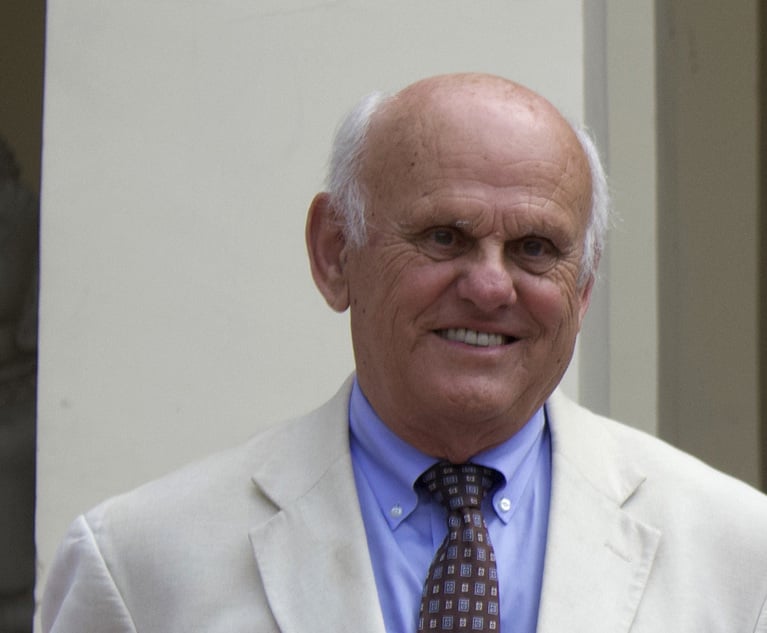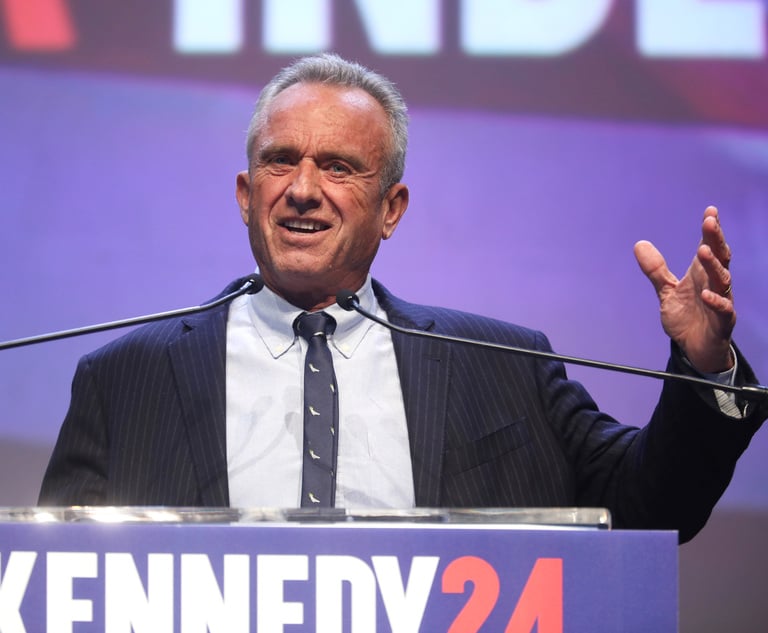Average Shareholder Settlement Value Dropped 75 Percent Last Year, Report Says
Laura Simmons, senior adviser at Cornerstone and co-author of the report, said the cases last year were just smaller.
March 14, 2018 at 07:44 PM
4 minute read
 Photo: Shutterstock.com
Photo: Shutterstock.com The average shareholder class action settlement was $18.2 million last year, down 75 percent from 2016 and well below the $57.7 million average over the past two decades, according to an annual report by Cornerstone Research.
The report, released Wednesday, said that the total of all settlements was $1.5 billion, less than a quarter of total settlement values in 2016 and the second-lowest level in the past decade.
Laura Simmons, senior adviser at Cornerstone and co-author of the report, said the cases last year were just smaller.
“It is one of the largest declines we've seen over the years,” she said. “These were just smaller cases for the most part. What is interesting is how small those cases really are.”
➤➤ Get class action news and commentary straight to your in-box with Critical Mass by Amanda Bronstad. Learn more and sign up here.
The report was in line with a report earlier this year of NERA Economic Consulting that found average settlement value in 2017 was $25 million, a drop of more than 40 percent from 2016 and the lowest since 2001.

The lower valuations come as the number of settlements dropped only slightly to 81, compared to 2016, according to Cornerstone's report. In fact, a Cornerstone report earlier this year found that shareholder class action filings hit record highs in 2017.
But more than half the settlements last year were $5 million or less—a number and proportion not seen in the past decade.
“There's really a substantial drop in the size of the cases,” Simmons said. “And that's driven by smaller losses in those cases. The other thing that contributed to the smaller size of case is that the defendant firms were also smaller.”
Also, for the first time in five years, there was no settlement worth more than $250 million. The highest of the four mega-settlements—those worth $100 million or more—was a $210 million deal with Salix Pharmaceuticals Ltd. that Bernstein Litowitz Berger & Grossmann handled.
But mega-settlements only made up $630 million, or 43 percent, of the total settlement value last year, the report said. In 2016, by comparison, they made up $5 billion.
Simmons said she did not expect the trend to continue, noting the $2.95 billion partial settlement with Petrobras this year.
“We already know about the Petrobras settlement and a couple of others that will drive up the total settlement dollars and are likely to increase the average, as well,” she said.
A few other trends in the Cornerstone report were:
- Institutional investors appeared less frequently as lead plaintiffs, even in larger cases. “The factors that would play into that of course are whether they are getting a benefit,” Simmons said. “There's time and effort involved for the institutions to serve as lead plaintiffs, so it comes down to a cost-benefit analysis for them.”
- An increasing number of derivative actions accompanied securities class actions. “It's surprising to see an increase in derivative actions accompanying what was by and large a set of smaller cases,” Simmons said. But it might be a business decision: “We know they're often brought by plaintiffs who vie for the position of lead plaintiff in the securities class, and then are not appointed, and still want to be part of the case, so they file an accompanying derivative action,” Simmons said. “It comes down to the way they manage their business or decide they want to be involved in more cases.”
This content has been archived. It is available through our partners, LexisNexis® and Bloomberg Law.
To view this content, please continue to their sites.
Not a Lexis Subscriber?
Subscribe Now
Not a Bloomberg Law Subscriber?
Subscribe Now
NOT FOR REPRINT
© 2025 ALM Global, LLC, All Rights Reserved. Request academic re-use from www.copyright.com. All other uses, submit a request to [email protected]. For more information visit Asset & Logo Licensing.
You Might Like
View All
4th Circuit Upholds Virginia Law Restricting Online Court Records Access
3 minute read
'Where Were the Lawyers?' Judge Blocks Trump's Birthright Citizenship Order
3 minute read

RFK Jr. Will Keep Affiliations With Morgan & Morgan, Other Law Firms If Confirmed to DHHS
3 minute readTrending Stories
- 1How This Dark Horse Firm Became a Major Player in China
- 2Bar Commission Drops Case Against Paxton—But He Wants More
- 3Pardons and Acceptance: Take It or Leave It?
- 4Gibbons Reps Asylum Seekers in $6M Suit Over 2018 ‘Inhumane’ Immigration Policy
- 5DC Judge Chutkan Allows Jenner's $8M Unpaid Legal Fees Lawsuit to Proceed Against Sierra Leone
Who Got The Work
J. Brugh Lower of Gibbons has entered an appearance for industrial equipment supplier Devco Corporation in a pending trademark infringement lawsuit. The suit, accusing the defendant of selling knock-off Graco products, was filed Dec. 18 in New Jersey District Court by Rivkin Radler on behalf of Graco Inc. and Graco Minnesota. The case, assigned to U.S. District Judge Zahid N. Quraishi, is 3:24-cv-11294, Graco Inc. et al v. Devco Corporation.
Who Got The Work
Rebecca Maller-Stein and Kent A. Yalowitz of Arnold & Porter Kaye Scholer have entered their appearances for Hanaco Venture Capital and its executives, Lior Prosor and David Frankel, in a pending securities lawsuit. The action, filed on Dec. 24 in New York Southern District Court by Zell, Aron & Co. on behalf of Goldeneye Advisors, accuses the defendants of negligently and fraudulently managing the plaintiff's $1 million investment. The case, assigned to U.S. District Judge Vernon S. Broderick, is 1:24-cv-09918, Goldeneye Advisors, LLC v. Hanaco Venture Capital, Ltd. et al.
Who Got The Work
Attorneys from A&O Shearman has stepped in as defense counsel for Toronto-Dominion Bank and other defendants in a pending securities class action. The suit, filed Dec. 11 in New York Southern District Court by Bleichmar Fonti & Auld, accuses the defendants of concealing the bank's 'pervasive' deficiencies in regards to its compliance with the Bank Secrecy Act and the quality of its anti-money laundering controls. The case, assigned to U.S. District Judge Arun Subramanian, is 1:24-cv-09445, Gonzalez v. The Toronto-Dominion Bank et al.
Who Got The Work
Crown Castle International, a Pennsylvania company providing shared communications infrastructure, has turned to Luke D. Wolf of Gordon Rees Scully Mansukhani to fend off a pending breach-of-contract lawsuit. The court action, filed Nov. 25 in Michigan Eastern District Court by Hooper Hathaway PC on behalf of The Town Residences LLC, accuses Crown Castle of failing to transfer approximately $30,000 in utility payments from T-Mobile in breach of a roof-top lease and assignment agreement. The case, assigned to U.S. District Judge Susan K. Declercq, is 2:24-cv-13131, The Town Residences LLC v. T-Mobile US, Inc. et al.
Who Got The Work
Wilfred P. Coronato and Daniel M. Schwartz of McCarter & English have stepped in as defense counsel to Electrolux Home Products Inc. in a pending product liability lawsuit. The court action, filed Nov. 26 in New York Eastern District Court by Poulos Lopiccolo PC and Nagel Rice LLP on behalf of David Stern, alleges that the defendant's refrigerators’ drawers and shelving repeatedly break and fall apart within months after purchase. The case, assigned to U.S. District Judge Joan M. Azrack, is 2:24-cv-08204, Stern v. Electrolux Home Products, Inc.
Featured Firms
Law Offices of Gary Martin Hays & Associates, P.C.
(470) 294-1674
Law Offices of Mark E. Salomone
(857) 444-6468
Smith & Hassler
(713) 739-1250










